Dublin
2007 Schools Wikipedia Selection. Related subjects: European Geography
| Dublin Baile Átha Cliath |
||
 |
||
|---|---|---|
| Obedientia Civium Urbis Felicitas (Latin for "Happy the city where citizens obey") |
||
| Location | ||
|
|
||
|
WGS-84 ( GPS) Coordinates:
53.3472° N 6.2592° W |
||
| Statistics | ||
| Province: | Leinster | |
| County: | ' Dublin Region' | |
| Area: | 114.99 km² | |
| Population (2006) | 505,739 | |
| Website: www.dublincity.ie | ||
Dublin ( Irish: Baile Átha Cliath) is the capital and the largest city of the Republic of Ireland, located near the midpoint of Ireland's east coast, at the mouth of the River Liffey and forms the centre of the Dublin Region. Originally founded as a centre of Viking settlement, the city has been Ireland's capital city since mediæval times.
Dublin City is the entire area administered by Dublin City Council. However, when most people talk about 'Dublin', they also refer to the contiguous suburban areas that run into the adjacent counties of Dun Laoghaire-Rathdown, Fingal and South Dublin. This area is sometimes known as 'Urban Dublin' or the ' Dublin Metropolitan Area'.
The population within the city (i.e. the administrative area controlled by Dublin City Council) was 505,739 at the census of 2006. Beyond this, at the same census the Dublin Region population was 1,186,159, whilst the Greater Dublin Area had a figure of 1,661,185.
A person from Dublin is known as a Dubliner or colloquially as a Dub. They can also be mildly pejoratively called a Jackeen by other Irish people. In a 2003 survey, Dublin was found to be the best capital city in Europe to live in, and the Republic of Ireland was also the best country to live in.
Name
The name Dublin is an anglicism of 'Dubh Linn' (Irish, meaning 'black pool'), though some doubt this derivation. Historically, in the old script used for the Irish language, 'bh' was written with a dot placed over the 'b' — thus appearing to be 'Dub Linn' or 'Dublinn'. The Norman-speaking English who arrived in Irish-speaking Ireland, omitted the 'dot' (or buailte in Irish), and spelled the town's name variously as 'Develyn' or 'Dublin'.
Meanwhile, the city's name in Modern Irish — 'Baile Átha Cliath' ('The Town of the Ford of the Reed Hurdles') — actually refers to the settlement, founded in 988 by High King Mael Sechnaill II, which adjoined the town of Dubh Linn proper, at the Black Pool.
Some sources have suggested that 'Dublin' is of Scandinavian origin, cf. Icelandic: 'djúp lind' ('deep pond'). However, the name 'Dubh Linn' pre-dates the arrival of the Vikings in Ireland, and the Old Norse (and modern Icelandic) name for Dublin is simply the words 'Dubh Linn' re-spelled as if they were Old Norse: 'Dyflinn' (correctly pronounced "Duev-linn" — indeed, the letter 'y' is still pronounced like the vowel in 'ewe' in Modern Norwegian, Swedish, etc., just as it was in Old Norse; Icelandic, while keeping the spelling, has changed this sound to /i/).
History
The earliest reference to Dublin is in the writings of Ptolemy, the Greek astronomer and cartographer, around the year A.D. 140, who called it Eblana Civitas. The settlement 'Dubh Linn' dates perhaps as far back as the first century BC; 'Baile Átha Cliath' or simply 'Áth Cliath' was founded in 988, and the two towns eventually became one.
The modern city retains the Anglicised Irish name of the former and the original Irish name of the latter. After the Norman invasion of Ireland, Dublin became Ireland's capital, with much of the power centring on Dublin Castle until independence. From the 14th to late 16th centuries, Dublin and the surrounding area - known as the Pale - was the largest area of Ireland under government control.
From the 17th century the city expanded rapidly, helped by the Wide Streets Commission. Georgian Dublin was, for a time, the second city of the British Empire after London. Much of Dublin's most notable architecture dates from this time. The Easter Rising of 1916 left the capital in an unstable situation and the Anglo-Irish War and Irish Civil War left the capital in ruins, with many of its finest buildings destroyed. The Irish Free State rebuilt much of the city's buildings and moved parliament to Leinster House, but took no bold tasks such as remodelling. After The Emergency (World War II), Dublin remained a capital out of time, modernisation was slow and finally the 1960s saw change begin. In recent years the infrastructure of Dublin has changed immensely, with enormous private and state development of housing, transport, and business. (See also Development and Preservation in Dublin). Some well-known Dublin street corners are still named for the pub or business which used to occupy the site before closure or redevelopment.
Since the beginning of English rule in the 12th century, the city has served as the capital of the island of Ireland in the varying geopolitical entities:
- the Lordship of Ireland ( 1171– 1541)
- the Kingdom of Ireland ( 1541– 1800)
- the island as part of the United Kingdom of Great Britain and Ireland ( 1801– 1922)
- the Irish Republic ( 1919– 1922)
From 1922, following the partition of Ireland, it served as the capital of the Irish Free State ( 1922– 1937) and now as the capital of the Republic of Ireland. (Many of these states co-existed or competed within the same timeframe as rivals within either British or Irish constitutional theory.)
Climate
Dublin enjoys a maritime temperate climate characterised by mild winters, cool summers, and a lack of temperature extremes. Contrary to popular belief, Dublin does not experience as high rainfall as the West of Ireland, which receives twice that of the capital city. Dublin has fewer rainy days, on average, than London. The average maximum January temperature is 8°C (46°F), the average maximum July temperature is 20°C (68°F). The sunniest months, on average, are May and June, with 6 hours of sunlight daily (though actual daylight in these months is a lot more). The wettest months, on average, are December and August, with 74 mm (2.9 inches) of rain. The driest month is April, with 45 mm (1.7 inches) of rain. The total average annual rainfall (and other forms of precipitation) is 762 mm (29.5 inches), this is lower than the average rainfall in Sydney, New York City and even Dallas. Due to Dublin's high latitude, it experiences long summer days (around 19 hours of daylight) and short winter days (as short as 9 hours of daylight). Dublin, like the rest of Ireland, is relatively safe from common natural disasters (tornadoes, hurricanes, earthquakes, tidal waves/tsunamis etc).
Strong winds from Atlantic storm systems can affect Dublin, though usually less severe than other parts of Ireland. Severe winds are most likely during mid-winter, but can occur anytime, especially between October and February inclusive. During one of the stormiest periods of recent times, a gust of 151 km/hr (94 mph) was recorded at Casement Aerodrome on 24 December 1997.
Dublin has a microclimate, which makes the city a few degrees warmer than surrounding areas. There is also a slight temperature difference between the city centre and the city's suburbs, with the city centre slightly warmer, as it is more built up. There are even slight differences between the city centre and the Airport, just 12 kilometres north.
The city is not noted for its temperature extremes due to its mild climate. The lowest recorded temperature was −12°C (10.4°F). The other extreme was 31°C (88°F), being the highest recorded. The main precipitation in winter is rain. The city can experience some snow showers during the months of November–April inclusive, but lying snow is rare (on average, only 4/5 days of the year). Hail occurs more often than snow, and is most likely during the winter/spring months. Another rare type of weather is thunder and lightning, which is most common around the summer months. Typically, the coldest months in Dublin are December, January and February. However, temperatures in Summer in recent years have been rising to substantially above average figures (e.g. 31°C/88°F recorded in July 2006, over 11°C higher than the maximum average for that month), especially during heat waves in 2003 and 2006.
| Month | Jan | Feb | Mar | Apr | May | Jun | Jul | Aug | Sep | Oct | Nov | Dec | Year |
|---|---|---|---|---|---|---|---|---|---|---|---|---|---|
| Average high | 8°C (46°F) | 8°C (46°F) | 10°C (50°F) | 13°C (55°F) | 15°C (59°F) | 18°C (64°F) | 20°C (68°F) | 19°C (66°F) | 17°C (63°F) | 14°C (57°F) | 10°C (50°F) | 8°C (46°F) | 13°C (55°F) |
| Average low | 1°C (34°F) | 2°C (36°F) | 3°C (37°F) | 4°C (39°F) | 6°C (43°F) | 9°C (48°F) | 11°C (52°F) | 11°C (52°F) | 9°C (48°F) | 6°C (43°F) | 4°C (39°F) | 3°C (37°F) | 6°C (43°F) |
| Total rainfall | 67mm (2.6") | 55mm (2.1") | 51mm (2") | 45mm (1.7") | 60mm (2.3") | 57mm (2.2") | 70mm (2.7") | 74mm (2.9") | 72mm (2.8") | 70mm (2.7") | 67mm (2.6") | 74mm (2.9") | 762mm (29.5") |
Culture
General situation
Dublin is a major European cultural centre and the origin of many prominent literary figures including Jonathan Swift, Bram Stoker, Oscar Wilde, William Butler Yeats, James Joyce, J.M. Synge, George Bernard Shaw, Seán O'Casey, Samuel Beckett, Brendan Behan, and Roddy Doyle. Dubliners is a collection of short stories by James Joyce about incidents and characters typical of residents of the city in the early part of the 20th century. Ulysses, also by Joyce, is a novel set in Dublin, full of topographical detail and is both acclaimed and controversial.
The National Print Museum of Ireland, the Irish Museum of Modern Art, both the National Gallery and the National Library of Ireland, the Hugh Lane Municipal Gallery, the Chester Beatty Library and three centres of the National Museum of Ireland are located in Dublin.
While there are a number of galleries and art centres located in the city centre, such as The City Arts Centre, Four, The Douglas Hyde Gallery, The Project Arts Centre and The Royal Hibernian Academy.
Temple Bar is a popular night life location and attracts many people from Great Britain and beyond for weekend visits.
The city is one of the most youthful in the world — an estimated 50% of inhabitants are younger than 25.
Multicultural Dublin
Despite having a long tradition of emigration that continued up until the early 1990s, Dublin now has a sizeable number of immigrants especially from Poland, China, the United Kingdom, Nigeria and Romania. There are also considerable numbers from fellow E.U. member states, the United States, Australia, New Zealand, and Russia, while over the last decade a large number of Irish who previously emigrated, have returned to settle in the city.
Education
Dublin is the primary centre of education in Ireland, with three universities and several other higher education institutions. Altogether, there are twenty third-level institutes in the city. The University of Dublin is the oldest university in Ireland dating from the 16th Century. Its sole constituent college, Trinity College, was established by Royal Charter under Elizabeth I and was closed to Roman Catholics until Catholic Emancipation; the Catholic hierarchy then banned Roman Catholics from attending it until 1970. The National University of Ireland has its seat in Dublin which is also the location of the associated constituent university of University College Dublin (UCD), the largest university in Ireland; although it is located in Dun Laoghaire-Rathdown, just outside the city of Dublin boundary. Dublin City University (DCU) is the most recent university created in Dublin and specialises in business, engineering, and science courses, particularly with relevance to industry. The Royal College of Surgeons in Ireland (RCSI) is an independent medical school located on St. Stephen's Green in the city centre. The National University of Ireland, Maynooth, another constituent university of the NUI, is located in neighbouring Co. Kildare, about 25 km from Dublin's city centre.
Dublin Institute of Technology (DIT) is a modern technical college and is the country's largest non-university third level institution; it specialises in technical subjects but also offers many arts and humanities courses. It is soon to move to a new campus at Grangegorman. Two suburbs of Dublin, Tallaght and Blanchardstown have respective Institutes of Technology ( Institute of Technology, Tallaght) ( Institute of Technology, Blanchardstown). The National College of Art and Design (NCAD) and Dun Laoghaire Institute of Art, Design and Technology (DLIADT) support training and research in art, design and media technology.
There are also various other smaller specialised colleges, including private ones, in the city. Examples include The Gaiety School of Acting which hosts a two year intensive degree in acting, and Griffith College Dublin, which is the largest independent institute of third level education in the country, and located in the old Griffith Barracks.
Exhibitions
- 1853 — Great Industrial Exhibition (1853)
- 1865 — International Exhibition of Arts and Manufactures (1865)
- 1874 — International Exhibition of Arts and Manufactures (1874)
Northside and Southside
Traditionally, a north south division has existed in Dublin with the dividing line provided by the River Liffey. The Northside is seen by some as working-class, while the Southside is seen as middle and upper middle class. Dublin postal districts reflect the North/South divide, with odd numbers being used for districts on the Northside, e.g: Phibsboro is in Dublin 7, and even numbers for ones on the Southside, e.g: Sandymount is in Dublin 4.
This division dates back centuries, certainly to the point when the Earl of Kildare built his residence on the then less regarded Southside. When asked why he was building on the South Side, he replied "Where I go, fashion follows me", and indeed he was promptly followed by most other Irish peers.
The Northside/Southside divide is punctuated by examples of Dublin "sub-culture" stereotypes, with upper-middle class constituents seen as tending towards an accent and demeanour synonymous with (but not exclusive to) the Dublin 4 postcode on the Southside (see Dublin 4, Ross O'Carroll-Kelly), and working-class Dubliners seen as tending towards accents and demeanour associated with (but not exclusive to) Northside and inner-city Dublin neighbourhoods. (see Scanger)
This simplification of economic and social communities in Dublin ("southside rich, liberal and snobby"/"northside poor, industrial and common") does not survive more than a few real-world examples however. For example, the President of Ireland's residence, Áras an Uachtaráin, is on the Northside, although its postal district is Dublin 8, a Southside number. Similarly, some of Dublin's working-class suburbs such as Tallaght, Kimmage, Ballinteer, Dolphin's Barn, Crumlin, Inchicore, Ringsend, Irishtown, Clondalkin and Ballyfermot, are in fact located south of the river and seven wealthy suburbs, Clontarf, Glasnevin, Howth, Malahide, Portmarnock, Sutton and Castleknock are found on the Northside.
The north-south divide has mellowed considerably in the past number of years. This is primarily due to the favourable economic conditions currently in Ireland and the emergence of the Celtic Tiger economy in Ireland. Correspondingly, Dublin has progressed to become one of the wealthiest cities in Europe.
The economic divide in Dublin is east-west as well as north-south (the east side of the city generally being wealthier than the west side, although this too is only a rough guide). There are significant social divisions evident between the coastal suburbs in the east of the city, including those on the northside, and the newer developments further to the west. In reality, however, colloquial usage by natives of Dublin has the River Liffey constitute the socio-economic boundary.
In 2006, the Economist Intelligence Unit ranked Dublin as the 16th most expensive city in the world, and the Mercer World-wide quality of living survey rated Dublin as the city with the 24th best quality of life in the world .
Sport
The headquarters of almost all of Ireland's sporting organisations are located in Dublin. Croke Park, an 82,500-capacity stadium near Drumcondra, is the base of the Gaelic Athletic Association and hosts Gaelic Football and Hurling games during the summer months and on St. Patrick's Day, and International rules football in alternating years. The Dublin branch of the Gaelic Athletic Association play their league games at Parnell Park.
Lansdowne Road is a 48,000 capacity stadium owned by the Irish Rugby Football Union and is also the venue for home games of the Republic's national football (soccer) team. Lansdowne Road is due to be demolished at the end of 2006 and replaced with a state of the art 50,000 all-seater stadium.
Dalymount Park, in Phibsboro and the traditional Home of Irish Soccer, is now used only for home games of local club Bohemian FC. Rivals Shelbourne FC play at Tolka Park, in Drumcondra, while St Patrick's Athletic play in Richmond Park in Inchicore on the south west edge of the city. Shamrock Rovers, Ireland's most successful club, are originally from Milltown but have spent the last two decades in search of a home, and hope to complete a new stadium in Tallaght sometime in 2006. The other senior soccer clubs are University College Dublin F.C., based in Belfield, and the now defunct Dublin City F.C. (formerly Home Farm F.C.).
The National Aquatic Centre, located in Blanchardstown, is the first building to open in the Sports Campus Ireland. There are several race courses in the Dublin area including Shelbourne Park ( Greyhound racing) and Leopardstown ( Horse racing). The world famous Dublin Horse Show at the RDS, Ballsbridge, which hosted the Show Jumping World Championships in 1982. There are also Basketball, Handball, Hockey and Athletics stadia within the city — most notably Morton Stadium in Santry, which held the athletics events of the 2003 Special Olympics.
The Dublin Marathon has been run in the city since 1980.
Entertainment
There is a vibrant night life in Dublin — the most internationally notorious area for these activities is the Temple Bar area south of the Liffey. This area has become synonymous with stag and hen parties and tourists, causing many locals to steer clear of the area. Temple Bar was, however, originally redeveloped as Dublin's cultural quarter and retains part of this spirit in the form of street performers, drummers, and many intimate small music venues. The area south east of Stephen's Green--Harcourt Street, Camden Street, Wexford Street and Leeson Street--has also become a centre for some of the most popular nightclubs and pubs in Dublin.
There are several theatres within the city centre, the largest of which include the Abbey Theatre, the Gate Theatre, the Olympia Theatre, and the Gaiety Theatre, which opens its doors after the evening theatre production to host a variety of live music, dancing, and films. The Gaiety's bars are open later than any others in the city. The largest theatre in the city is the Mahony Hall in The Helix at Dublin City University in Glasnevin.
There are two large cinemas in the city centre; The Savoy Cinema and the Cineworld Cinema are located north of the Liffey. Alternative and special-interest cinema can be found in the Irish Film Institute in Temple Bar, and in the Screen Cinema on d'Olier St. Numerous larger cinemas can be found in the city's suburbs.
Government
City
The City is governed by Dublin City Council (formerly called Dublin Corporation) which is presided over by the Lord Mayor of Dublin, who is elected for a yearly term and resides in the Mansion House. Dublin City Council is based in two major buildings. Council meetings take place in the headquarters at Dublin City Hall, the former Royal Exchange taken over for city government use in the 1850s. Many of its administrative staff are based in the controversial Civic Offices on Wood Quay.
The City Council is a unicameral assembly made up of 52 members. These members are elected every five years from Local Election Areas. The party with the majority of seats decides who sits on what committee, what policies are followed, and who becomes Lord Mayor. Chaired by the Lord Mayor, the Council passes an annual budget for spending on housing, traffic management, refuse, drainage, planning, etc. The Dublin City Manager is responsible for the implementation of decisions of the City Council.
National
The national parliament of the Republic of Ireland (called the Oireachtas) consists of the President of Ireland and two houses, Dáil Éireann (Chamber of Deputies) and Seanad Éireann (Senate). All three are based in Dublin. The President of Ireland lives in Áras an Uachtaráin, the former residence of the Governor-General of the Irish Free State in the city's largest park, Phoenix Park. Both houses of the Oireachtas meet in Leinster House, a former ducal palace on the south side of the city. The building has been the home of Irish parliaments since the creation of the Irish Free State on December 6, 1922.
The Irish Government is based in the Government Buildings, a large building designed by Sir Aston Webb, the architect who created the Edwardian facade to Buckingham Palace. Initially what is now Government Buildings was designed for use as the Royal College of Science, but in 1921 the House of Commons of Southern Ireland met there. Given its location next to Leinster House, the Irish Free State government took over part of the building to serve as a temporary home for some ministries. However both it and Leinster House (originally meant to be a temporary home of parliament) became the permanent homes of the government and parliament respectively.
The previous old Irish Houses of Parliament of the Kingdom of Ireland are located in College Green.
Economy & Infrastructure
Transport
Dublin is at the centre of Ireland's transport system. Dublin Port is the country's most important sea port. Dublin Airport is the busiest airport by far on the island, registering nearly 19 million passengers in 2005, making it the 14th busiest airport in Europe with the capital's airport offering onward flights to other airports in Ireland, Europe, North America and the Middle East. Heuston Station and Connolly Station are the city's major railway stations, Heuston connects with the towns and cities in the south and west of the Republic while Connolly serves the Sligo, Wexford and Belfast routes.
Road network
Dublin is also the main hub of the country's road network. The M50 motorway (the busiest road in Ireland), a semi- ring road runs around the south, west and north of the city, connecting the most important national primary routes in the State that fan out from the capital to the regions. A toll of €1.80 applies on what is called the West-Link, two adjacent concrete bridges that tower high above the River Liffey near the village of Lucan. Construction of the M50 took almost 20 years, with the final section opening in June 2005. A court case regarding the destruction of medieval ruins at Carrickmines Castle delayed the final completion of the route. The M50 currently has two traffic lanes going either direction but plans are afoot to increase that to three. The National Roads Authority also intends to increase capacity at many of the motorway's busiest junctions by building triple-grade interchanges instead.
To complete the ring road, an eastern bypass is also proposed for the city of Dublin. The first half of this project is currently under construction, the Dublin Port Tunnel. It is scheduled to open in late 2006 and will mainly cater for heavy vehicles. When finished, Dublin City Council hopes to ban all unnecessary trucks and lorries from the city quays.
Though originally intended to be a two-lane single-bore system catering specifically to HGV traffic, the Port Tunnel has been built to motorway standard as two separate tunnels to cater for all traffic (although HGV traffic will not be tolled). The tunnels are deeper than originally planned to reduce disturbance to residential areas, and were built one kilometre longer and with more ancillary works to facilitate this.
The capital is also surrounded by what have been termed by Dublin City Council as an inner and outer orbital route. The inner orbital route runs roughly around the heart of the Georgian city from St. Stephen's Green to Mountjoy Square and from the King's Inns to St Patrick's Cathedral. The outer orbital route runs largely along the natural circle formed by Dublin's two canals, the Grand Canal and the Royal Canal, as well as the North and South Circular Roads.
Public transport
Around 46% of Greater Dublin's commuters walk, cycle or use public transport to get to work (as of 2002). The public transport system is made up of hundreds of bus routes, five suburban rail lines ( one electrified) and two light rail lines. Plans under the government's Transport 21 initiative are underway to build two high capacity metro lines, extend the electrified DART lines westward and to expand on the highly successful Luas light rail system. The public transport network is overlooked by the Dublin Transportation Office.
Greater Dublin Rail Map
Bus
The bulk of the public transport system in Dublin is made up of bus services operated by Bus Átha Cliath (Dublin Bus), which operates a network of nearly 200 daytime routes (identified by number and sometimes suffixed with a letter, e.g. 40, 40A, 40B, 40C, 40D) and 24 "Nitelink" overnight services which run on Monday to Saturday nights, which are identified by a number suffixed with "N" e.g. 40N). Apart from some tourist buses, all Dublin Bus' services are one-person operated, and daytime fares are determined by the number of fare stages travelled through — fares are payable in coin and only the exact fare is acceptable — if passengers overpay, they are issued "change tickets" which must be presented at the Dublin Bus office in O'Connell Street to be converted to cash. Alternatively, various pre-paid tickets and passes can be bought from Dublin Bus or its agents, and are processed by a validating machine on the right of the entrance door of the bus. Nitelink buses charge a flat fare regardless of the distance travelled. Dublin bus has been criticised for over crowding and under serviced routes. A number of smaller other bus companies provide services in Dublin as well.
Suburban Rail / DART
The Dublin Suburban Rail network is a system of five rail lines serving mainly commuters in the Greater Dublin Area, though some trains go even further to commuter towns such as Drogheda. One of these lines runs along Dublin Bay and is known as the Dublin Area Rapid Transit (DART) line and is the only electrified railway in the country. Over 80,000 people use the DART line alone every day.
Plans are underway to greatly expand the DART suburban railway network by boring a tunnel through Dublin City Centre allowing the creation of two separate DART lines. Each will run from the North West & South West of the city, through the city centre and then extend South and North respectively. This plan is made possible with the Dublin Interconnector rail project.
Light Rail / Tram
A two-line light rail/ tram network called the Luas opened in 2004 and has proved popular in the (limited) areas it serves, although the lack of a link between the two lines is widely criticised. There are, however, ambitious plans for the Luas, with seven projects (including a link between the two lines) planned for the future. It is estimated that around 80,000 people use the Luas daily.
In 2006 in was announced by the Railway Procurement Agency that the Luas system reached profitability ahead of schedule, after only a year of operation. The Luas is now the only mass transit in the country to operate without Government assistance, and among the few in Europe
The Future
The Irish Government has launched a national transport plan which is expected to cost the government €34.4 billion over the next 10 years. Most of this will go towards the Dublin Port Tunnel, seven new Luas projects, two Metro lines, DART extensions and an underground station at St. Stephen's Green integrating all services. Another project is the Interconnector which will be an underground tunnel connecting Connolly and Heuston stations by rail, via St. Stephen's Green. This map shows how the Greater Dublin Area rail network is projected to look by 2015. By the time Transport 21 is complete, it is estimated that over 365 millon passenger journeys will be made in the Greater Dublin Area on all forms of public transport annually, or 1 million daily (on average).
Industry and Economy
Probably the most famous industry in Dublin is brewing: Guinness has been brewed at the St. James's Gate Brewery since 1759.
During the Celtic Tiger years of the mid to late nineties a large number of pharmaceutical and information technology companies have located in Dublin and its suburbs and there are many Information and Communications Technology companies operating in and around the city. Microsoft's EMEA Operations Centre is located in Sandyford Industrial Estate to the south of the city and Google and Amazon have established operational bases in the city. Intel and Hewlett-Packard have large manufacturing plants in Leixlip, County Kildare, a suburb to the west of Dublin. Google, Yahoo! and PayPal (among others) also have their European headquarters in Dublin. Dublin is internationally recognised for its large amount of high-tech industrial estates, business centres and financial centres - which have led it to be known as the " Silicon Valley of Europe".
Dublin is at the centre of Ireland's economy, and the Greater Dublin Area contributes over €60 billion ($75.7 billion) to the total Irish GDP, or around 45%. Banking, finance and commerce are also important in the city - the IFSC alone handles over €1 trillion ($1.2 trillion) a year. And many international firms have established major headquarters in the city (eg. Citibank, Commerzbank). Also located in Dublin is the Irish Stock Exchange (ISEQ), Internet Neutral Exchange (INEX) and Irish Enterprise Exchange (IEX).
In 2005, around 800,000 people were employed in the Greater Dublin Area, of which around 600,000 were employed in the services sector and 200,000 were employed in the industrial sector.
The Celtic Tiger boom has led to a sharp increase in construction, which is now also a major employer, especially for immigrants. Redevelopment is taking place in large projects such as Dublin Docklands, Spencer Dock, "A New Heart for Dublin" and others, transforming once run-down industrial areas in the city centre. Dublin City Council seems to now have loosened the former limits on "high-rise" structures. The current tallest building, Liberty Hall, is only 59.4m tall; already under construction in the city is Heuston Gate, a 117m building (134m including spire). The 120m Britain Quay Tower and the 120m Point vilage tower have been approved.Construction has now started on the latter. Approval has now also been given for a tower 1 and a half times the size of liberty hall in Sandyford,south Dublin.
Sister Cities
 Barcelona, Spain
Barcelona, Spain Budapest, Hungary
Budapest, Hungary Liverpool, United Kingdom
Liverpool, United Kingdom Matsue, Japan
Matsue, Japan San Jose, United States of America
San Jose, United States of America
Tourist Attractions
Please note - This is an incomplete list
- Dublinia
- Dublin Castle
- Dublin Zoo
- Guinness Storehouse
- Kilmainham Gaol
- National Gallery
- National Museum
- Temple Bar
- Modern Art Museum Kilmainham
- Áras an Uachtaráin (President's Residence)
Additional reading
- Pat Liddy, Dublin A Celebration - From the 1st to the 21st Century (Dublin City Council, 2000) ( ISBN 0-946841-50-0)
- Maurice Craig, The Architecture of Ireland from the Earliest Times to 1880 (Batsford, Paperback edition 1989) ( ISBN 0-7134-2587-3)
- Frank McDonald, Saving the City: How to Halt the Destruction of Dublin (Tomar Publishing, 1989) ( ISBN 1-871793-03-3)
- Edward McParland, Public Architecture in Ireland 1680-1760 (Yale University Press, 2001) ( ISBN 0-300-03064-1)
- Hanne Hem, Dubliners, An Anthropologist's Account, Oslo, 1994
- John Flynn and Jerry Kelleher, Dublin Journeys in America (High Table Publishing, 2003) ( ISBN 0-9544694-1-0)
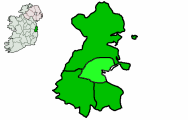


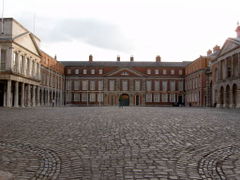
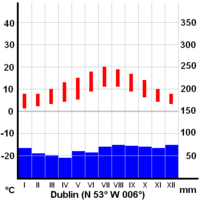

![Front Square and Campanile, Trinity College, Dublin, Ireland [1]](../../images/41/4126.jpg)
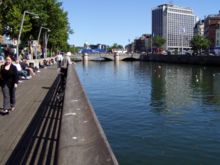

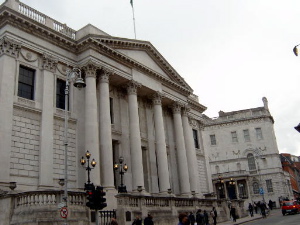
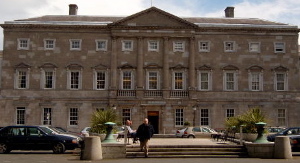

![Space Radar Image of Dublin with the Wicklow Mountains to the bottom left[2].](../../images/41/4134.jpg)




